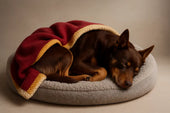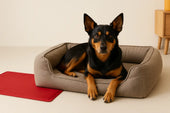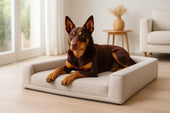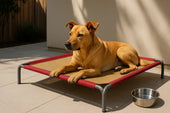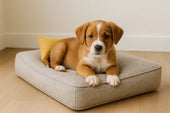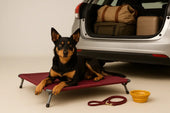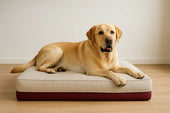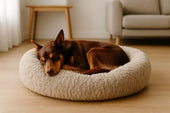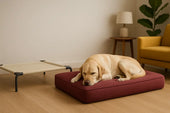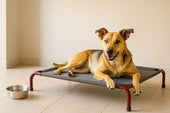Key Takeaways
- Discover Five Inspiring DIY Dog Bed Projects: Learn how to craft comfortable, durable, and stylish dog beds at home using affordable materials and straightforward methods.
- Practical, Budget-Friendly, and Customisable: Each project is suitable for Australian pet owners seeking unique beds tailored to their pet’s needs, home décor, and climate.
- Expert Advice and Reliable References: Access professional tips, in-depth guidance, and real-world advice from Australian pet experts, veterinarians, and leading pet care websites.
- Sustainable, Safe, and Eco-Friendly: Embrace upcycling and eco-conscious approaches to reduce waste and keep your pet safe from toxins and allergens commonly found in store-bought products.
- Easy for All Skill Levels: Whether you’re a crafty enthusiast or a beginner, you’ll find step-by-step instructions, visual references, and troubleshooting tips to ensure your project’s success.
Introduction
Every Australian dog deserves a bed that is as comfortable, secure, and unique as they are. While pet stores offer a range of ready-made options, more pet owners are discovering the benefits of creating their own dog beds at home. Not only does a DIY approach allow you to customise the bed to perfectly suit your pet’s size, sleeping style, and health needs, but it also offers an opportunity to be creative, eco-friendly, and budget-conscious.
According to the Australian Veterinary Association, proper rest is vital to your dog’s health, behaviour, and overall happiness. Yet, finding a commercially available bed that ticks every box for durability, support, and style can be surprisingly challenging—and expensive. That’s why homemade dog beds are gaining popularity across Australia, from city apartments in Sydney to country homes in rural Queensland.
This article will guide you through five innovative DIY dog bed projects that you can start (and often finish) in a single weekend. Each project includes step-by-step instructions, expert tips, and plenty of ideas for personalisation. Whether you’re upcycling an old jumper, transforming a vintage suitcase, or crafting a raised cot perfect for hot Aussie summers, you’ll discover a rewarding way to show your dog how much you care.
Let’s dive in and help you create a comfortable haven for your furry friend—one that’s practical, stylish, and built to last.
The Benefits of Making Your Own Dog Bed
Making your own dog bed is more than just a fun weekend project. For many Australian pet owners, it’s an opportunity to offer their dog a truly personalised place of rest and relaxation—while saving money and reducing waste. Here’s why thousands of pet lovers across the country are embracing DIY dog beds:
1. Cost-Effectiveness and Sustainability
Dog beds sold at major pet retailers can be surprisingly costly, especially for larger breeds or specialty options. DIY dog beds, on the other hand, often cost a fraction of the price. Many projects can be completed using upcycled materials found around the house—like old pillows, jumpers, or wooden pallets—reducing both expenses and landfill waste. This approach aligns perfectly with Australia’s growing focus on sustainability and conscious consumption.
Expert Insight:
"Upcycling is a fantastic way to reduce your environmental impact and create something unique for your pet," says Sustainability Victoria.
2. Customisation for Your Dog’s Needs
No two dogs are the same. Some love to stretch out, others curl into the smallest spaces. DIY lets you design a bed that fits your dog’s exact size and preferred sleep style. If your dog has special needs—like joint pain or allergies—you can choose hypoallergenic materials or add extra padding for support.
Veterinarian’s Perspective:
"Orthopaedic support is especially important for older dogs and large breeds. A homemade bed allows you to control the quality of the filling and cover materials," explains Dr. Anne Quain, a Sydney-based veterinarian and lecturer at the University of Sydney (The Conversation).
3. Safer, Healthier Materials
Some imported pet beds have been found to contain potentially harmful chemicals, such as flame retardants or allergens (CHOICE). When you make your own, you can be confident in the safety of every component. Opt for washable, non-toxic fabrics and fillings, and avoid synthetic foams unless they’re certified safe for pets.
4. Emotional Value and Bonding
Many pet owners report that their dogs seem to appreciate the extra care that goes into a homemade bed. Making something by hand is a great way to bond, especially if you involve your family in the process. Some owners even say their pets sleep better when their scent or old clothing is used in the bed.
5. Creative Expression
DIY dog beds aren’t just practical—they’re also a chance to let your creativity shine! You can choose colours, patterns, and shapes that fit your home’s aesthetic. With so many options, every bed can be as unique as your dog.
6. Australian Perspective: Supporting Local
By choosing locally sourced materials or upcycling items from Australian op shops, you can further reduce your environmental impact and support local communities. Many regional councils and sustainability groups offer workshops on pet projects—check with your local Men’s Shed or community centre for upcoming events.
Essential Materials and Tools for DIY Dog Beds
Before you start your first DIY dog bed project, it’s important to gather the right materials and tools. The beauty of making your own dog bed is the ability to customise your choices based on your pet’s needs, your personal style, and the Australian climate. Below is a practical guide to selecting safe, durable, and cost-effective supplies, along with advice from industry experts.
Common Materials for DIY Dog Beds
- Fabric: Sturdy cotton, canvas, denim, or fleece are popular choices. For warm Australian summers, breathable natural fibres work best. In colder regions, opt for thicker, insulating fabrics.
- Filling: Old pillows, foam mattress toppers, shredded memory foam, or recycled clothing. For dogs with allergies, consider hypoallergenic fill (available at Spotlight Australia).
- Old Clothing: Repurposing jumpers, T-shirts, or jeans gives a familiar scent your dog will love.
- Wooden Pallets: Great for raised beds; make sure they’re heat-treated (marked “HT”) and not chemically treated.
- Suitcases: Vintage suitcases make charming beds for small dogs—just ensure the interior is clean and safe.
- PVC Pipes: Durable and lightweight, perfect for constructing elevated dog cots.
Tools You May Need
- Sewing Machine (for fabric-based beds)
- Heavy-Duty Scissors or Rotary Cutter
- Measuring Tape
- Staple Gun (for attaching fabric to wooden frames)
- Hammer and Nails or Screwdriver and Screws (for wooden projects)
- Hot Glue Gun (for non-sewing projects)
- Sandpaper or File (for smoothing wooden surfaces)
- Non-Toxic Paint or Stain (optional for customisation)
Safety Tips for Pets and DIYers
- Avoid Small, Loose Parts: Buttons, beads, and loose threads can be choking hazards.
- Select Non-Toxic Materials: Use child- and pet-safe glues, paints, and finishes.
- Smooth All Edges: Sand any rough wood or sharp plastic to prevent injuries.
- Test for Allergies: Wash all fabrics before use to remove potential irritants.
- Washable and Durable: Choose machine-washable fabrics and ensure the bed is easy to clean, especially in households with active dogs or during tick season in Australia.
Sourcing Materials in Australia
- Bunnings Warehouse – Affordable timber, foam, PVC pipes, and basic tools
- Spotlight Stores – Large selection of fabrics and sewing supplies
- Local Op Shops (e.g., Vinnies, Salvos) – Great for finding old clothes, suitcases, and blankets
- Reverse Garbage or Men’s Shed – Community groups that offer recycled materials and DIY support
Expert Tip:
"Always prioritise safety and comfort. If you’re using recycled or second-hand items, ensure they’re clean and free from pests or mould," advises Dr. Lisa Chimes, veterinarian and Australian pet health expert (Dr Lisa Vet).
Project 1: Upcycled Jumper Dog Bed
Turning an old jumper (or sweatshirt) into a cosy dog bed is one of the most heartwarming and sustainable DIY projects you can try. Not only does this approach reduce textile waste, but it also provides your dog with a bed that smells like you—something many pets find deeply comforting. This project is especially popular among Australian pet owners seeking eco-friendly solutions and has become a staple at community workshops across the country.
Why Choose an Upcycled Jumper Bed?
- Sustainability: Repurposes clothing that might otherwise end up in landfill.
- Comfort: The familiar scent and softness help anxious dogs feel more at ease.
- Budget-Friendly: Utilises items you likely already have at home.
- Quick and Easy: No advanced skills required—suitable for beginners.
Materials Needed
- 1 large jumper or sweatshirt (preferably thick cotton or fleece)
- 1 old pillow (or polyester stuffing, or cut-up fabric scraps)
- Needle and thread (or a sewing machine for speed)
- Scissors
- Pins (optional)
- A few handfuls of extra fabric scraps (optional, for added padding)
Step-by-Step Instructions
- Prepare the Jumper: Lay your jumper flat on a clean surface. Check for holes or weak seams and patch if necessary.
- Seal the Neck: Turn the jumper inside out. Use a needle and thread (or sewing machine) to sew the neck opening closed. Turn it right-side out again.
- Stuff the Arms: Fill both sleeves with pillow stuffing, fabric scraps, or polyester fill. Make sure the stuffing is evenly distributed for comfortable, padded sides.
- Add the Pillow: Slide your old pillow (or a thick wad of stuffing) into the body of the jumper, making sure it fills the space from shoulder to hem.
- Shape the Bed: Bring the sleeves around in a U-shape and pin (or hold) them in place to form the bolster sides. Adjust the pillow for even support.
- Sew It All Together: Sew the ends of the sleeves to each other, then sew the sleeves to the side of the jumper’s body to secure the bolster. Finally, stitch the bottom hem closed.
- Final Touches: Add extra stitches where needed for durability. Wash the completed bed on a gentle cycle before offering it to your dog.
Care Tips
- Machine Washable: Choose machine-washable fabrics and stuffing to make cleaning easy.
- Regular Maintenance: Fluff the bed weekly and wash as needed to prevent odours and allergens.
Australian Perspective
Upcycling is a growing trend among Australian families committed to sustainability. Organisations like Reverse Garbage regularly host workshops to teach creative re-use, and many local councils now support textile recycling initiatives. Making a dog bed from an old jumper is a small step with a big impact—good for your dog, your wallet, and the planet.
Expert Quote:
"Dogs have an extraordinary sense of smell, and sleeping on a bed made from their owner’s clothing can help ease anxiety, especially during storms or when left alone," explains Dr. Katrina Warren, Australian veterinarian and media personality (Katrina Warren Vet).
Further Reading:
Check out Better Homes & Gardens Australia – Upcycled Jumper Dog Bed for a visual guide.
Project 2: No-Sew Fleece Knot Bed
For pet owners looking for a simple, fast, and kid-friendly project, the no-sew fleece knot bed is a classic. This soft, cushiony bed requires no sewing experience or special equipment—just a pair of scissors and some cosy fleece. The result is a bed that’s gentle on your dog’s joints and easy to customise for any size, from tiny Terriers to big Labradors. It’s a perfect weekend activity for families and a safe option for homes with kids and pets alike.
Why Choose a No-Sew Fleece Knot Bed?
- Beginner-Friendly: No sewing skills needed.
- Quick and Fun: Can be completed in under an hour.
- Customisable: Make it as thick or thin as needed.
- Washable: Fleece is easy to clean and dries quickly.
- Gentle and Safe: Ideal for puppies, seniors, or dogs who love to nest.
Materials Needed
- 2 pieces of fleece fabric (each at least 15–30 cm longer and wider than your dog when curled up)
- Scissors (sharp fabric scissors work best)
- Measuring tape or ruler
- Pillow stuffing, old bedding, or polyester fibre fill
Step-by-Step Instructions
- Cut Your Fleece: Lay the two fleece pieces on top of each other, with the right sides facing out. Trim to your desired shape—rectangular or oval both work well.
- Cut Fringe: Use the measuring tape to cut a square out of each corner (usually about 10–12 cm). Then, cut 5–8 cm wide strips around all four sides of the fabric, cutting through both layers at once. Each strip should be 10–12 cm long.
- Tie the Knots: Begin tying the top and bottom strips together in double knots, all around three sides of the bed, leaving one side open.
- Add the Filling: Insert pillow stuffing, fibre fill, or an old duvet between the fleece layers, spreading it evenly for comfort and support.
- Close the Bed: Tie off the remaining side, making sure all knots are secure.
- Fluff and Finish: Give the bed a gentle shake and press down to distribute the filling evenly. Your no-sew fleece knot bed is ready!
Tips for Success
- Australian Climate: Use lightweight fleece for summer or double up layers for winter warmth.
- Patterned Fleece: Spotlight Australia stocks a variety of fun prints, from paw prints to classic tartan.
- Size Adjustments: This method scales up or down easily for all dog breeds.
Care and Cleaning
- Remove stuffing before washing or use a zippered pillowcase for easier care.
- Machine-wash the fleece on a gentle cycle and air dry.
Expert Quote:
"The no-sew fleece bed is perfect for young crafters and teaches the importance of making safe, cosy environments for pets," says Lisa Trezise, education coordinator at RSPCA South Australia.
Project 3: Wooden Pallet Dog Bed
If you want a durable, elevated, and stylish bed for your dog—especially for large breeds or outdoor use—a wooden pallet dog bed is an excellent choice. This project allows you to repurpose shipping pallets, readily available from hardware stores or recycling centres, into a bed that offers great support and ventilation. With a bit of sanding and creativity, you can craft a dog bed that looks fantastic in any Australian home or backyard.
Why Choose a Wooden Pallet Dog Bed?
- Sturdy and Long-Lasting: Perfect for dogs that chew or scratch.
- Raised Design: Keeps your pet off cold floors and allows airflow, ideal for Australia’s warm climate.
- Customisable: Easy to paint, stain, or decorate to suit your space.
- Eco-Friendly: Upcycles pallets that might otherwise end up as waste.
Materials Needed
- 1–2 wooden pallets (heat-treated and in good condition)
- Sandpaper or electric sander
- Hammer and nails or power drill and screws
- Non-toxic wood paint or stain (optional)
- Tape measure and pencil
- Saw (if resizing is needed)
- Cushion, mattress, or custom pillow for the bed base
Step-by-Step Instructions
- Select and Prepare the Pallets: Source pallets marked “HT” (heat-treated, not chemically treated). Inspect for nails, splinters, or damage and remove any hardware. Sand the entire surface thoroughly to avoid injuries.
- Cut and Assemble (if necessary): Resize the pallet if you want a specific bed size. For larger beds, you may stack or join two pallets together for extra height or width.
- Build the Frame: Depending on your design, you may want to add side rails using sections of another pallet or scrap wood. Attach with screws or nails for stability.
- Finishing Touches: Paint or stain the wood using a pet-safe product, available at Bunnings. Allow to dry completely before use.
- Add the Mattress or Cushion: Place a fitted cushion, foam mattress, or a homemade bed (like the fleece or jumper bed described earlier) inside the pallet frame.
- Place the Bed: Position your new bed indoors or in a sheltered outdoor spot. For outdoor use, ensure it’s on a level surface and consider raising it further with rubber feet or bricks to avoid contact with damp ground.
Safety Considerations
- Check for Splinters: Sand thoroughly and check regularly.
- Non-Toxic Finishes: Always use child- and pet-safe stains or paints.
- Outdoor Placement: For outdoor beds, choose weather-resistant cushions and covers.
Australian Perspective
Many Australian homes have easy access to free or cheap pallets from local stores or recycling centres. Community groups such as Men’s Shed sometimes run DIY days where you can learn woodworking basics and share tips with fellow pet owners. Outdoor pallet beds are particularly valued in regions with hot summers, as they help keep dogs cool and dry.
Expert Quote:
"Elevated beds provide superior comfort for large dogs, reducing pressure on joints and improving air circulation—a must in the Australian heat," says Dr. Matthew Holmes, veterinarian at Vetwest Animal Hospitals.
Further Reading:
Find detailed community advice and creative ideas at the Bunnings Workshop Community – Pallet Pet Beds.
Project 4: Suitcase Bed for Small Dogs
For a project that combines vintage style with cosy comfort, the suitcase dog bed is a standout. Perfect for small breeds or puppies, this upcycled bed transforms an old suitcase into a charming, functional piece
that blends seamlessly with your home décor. It’s a conversation starter, a sustainable choice, and a uniquely Australian twist for dog lovers who frequent op shops and flea markets.
Why Choose a Suitcase Bed?
- Unique and Stylish: Adds character to any room.
- Portable: Easy to move around your house or take when travelling.
- Eco-Friendly: Repurposes old suitcases and keeps them out of landfill.
- Customisable: Personalise with your choice of cushion, lining, or paint.
Materials Needed
- 1 hard-shell or sturdy vintage suitcase (clean and odour-free)
- Soft cushion, foam mattress, or pillow (custom fit to the suitcase base)
- Fabric for lining (cotton, fleece, or upholstery material)
- Scissors, fabric glue, or a staple gun
- Screwdriver and small screws (for adding legs, optional)
- Four wooden furniture legs or bun feet (optional for elevation)
- Non-toxic paint or varnish (optional)
Step-by-Step Instructions
- Choose and Prepare the Suitcase: Select a suitcase large enough for your dog to stretch out comfortably. Clean thoroughly with mild detergent. If it has a musty smell, air it out in the sun or use bicarb soda to absorb odours.
- Remove Unnecessary Parts: Take out dividers or flaps inside the suitcase. If you plan to add legs, use a screwdriver to remove any hardware from the base.
- Line the Interior: Cut your fabric to fit the inside of the suitcase. Use fabric glue or a staple gun to secure it neatly to the sides and base for a snug, cushioned effect.
- Add the Cushion or Mattress: Insert a soft cushion, foam mattress, or old pillow tailored to the suitcase’s dimensions. For extra comfort, sew or glue a matching cover for the mattress.
- Optional – Add Legs: To elevate the bed, screw wooden legs or bun feet into the bottom corners of the suitcase. This helps with airflow and gives your bed a chic, elevated look.
- Paint or Decorate (Optional): Personalise the outside with non-toxic paint, stencils, or even your dog’s name. Allow paint or varnish to dry fully before use.
- Place the Bed: Position in a cosy, draft-free spot. Suitcase beds are ideal for bedrooms, living rooms, or even home offices.
Tips for Success
- Australian Op Shops: Try Vinnies, Salvos, or council tip shops for affordable vintage suitcases.
- Travel-Friendly: The portable design is perfect for dogs that accompany you on road trips or holidays.
- Custom Fit: Tailor the cushion to your dog’s sleeping habits (firm for older dogs, plush for puppies).
Safety and Maintenance
- Check for sharp edges or rusty hinges before use.
- Wash the inner lining regularly and air out the suitcase in the sun to keep it fresh.
- Ensure all decorations and small parts are securely attached and safe for pets.
Australian Perspective
Australians are passionate about recycling and upcycling, and vintage suitcase beds are a popular feature at local makers markets and pet expos. Not only do they keep usable materials out of landfill, but they also showcase your creativity and commitment to sustainable living.
Expert Quote:
"Repurposing household items is both environmentally friendly and rewarding. A suitcase dog bed is a great example of how we can blend sustainability and comfort for our pets," notes the team at Australian House & Garden.
Further Reading:
Explore more stylish ideas at Australian House & Garden – Upcycled DIY Pet Bed.
Project 5: PVC Pipe & Canvas Dog Cot
The PVC pipe and canvas dog cot is a modern solution for dogs who need extra support, particularly in Australia’s hot climate. This elevated design keeps your dog cool by allowing air to circulate underneath, helps keep bedding dry, and is especially useful for outdoor use or for dogs with joint pain. It’s sturdy, chew-resistant, and easily customised for any size dog.
Why Choose a PVC Pipe & Canvas Dog Cot?
- Elevated Comfort: Keeps your dog off hard, hot, or cold floors.
- Great for Australian Summers: Airflow helps regulate your pet’s temperature.
- Joint-Friendly: Provides firm support for older dogs or those with arthritis.
- Easy to Clean: Canvas and PVC are both simple to wipe down or hose off.
- Customisable: Adjust size and height to perfectly fit your dog.
Materials Needed
- PVC pipes (choose diameter based on dog size; 20–25 mm for small dogs, 32 mm+ for large breeds)
- Four PVC corner connectors (elbows or tees)
- Canvas or strong outdoor fabric (available from Spotlight)
- Scissors, measuring tape, and marker
- Heavy-duty stapler or strong sewing machine (for fabric hem)
- PVC pipe cutter or hacksaw
- Optional: Non-slip rubber feet or adhesive pads
Step-by-Step Instructions
- Measure and Cut PVC Pipes: Measure your dog to determine the ideal bed size. Cut four pipes for the sides and four shorter pipes for the legs. Double-check measurements so your dog has plenty of room to stretch.
- Assemble the Frame: Fit the side pipes and corner connectors together to form a sturdy rectangle. Attach the legs at each corner, ensuring they’re all the same length for a level bed.
- Prepare the Canvas: Cut your canvas so it’s about 8–10 cm larger than the frame on all sides. This extra fabric will form a hem or pocket for stapling or sewing.
- Attach the Canvas:
- Option 1: Fold the fabric edges under and staple directly to the bottom of the frame (tension is key to avoid sagging).
- Option 2: Sew a hem to form a sleeve and slide the pipes through for a seamless finish.
- Final Assembly: Double-check that the fabric is tight and the frame is stable. Add non-slip pads to the bottom of the legs if using indoors.
- Cleaning and Maintenance: The canvas can be removed for washing. Wipe down the PVC with a damp cloth as needed.
Tips for Success
- Australian Conditions: Use UV-resistant canvas and PVC to prevent deterioration from sun exposure.
- Custom Height: Adjust leg length to suit your dog’s age and mobility.
- Indoors & Outdoors: Great for verandas, patios, or as a crate insert.
- Non-Slip Feet: Add rubber feet for safety on tiled or wooden floors.
Safety and Maintenance
- Check the cot regularly for loose connections or signs of chewing.
- Avoid excessive sagging in the fabric, which can strain your dog’s joints.
- Keep the cot out of direct midday sun to avoid overheating the frame.
Australian Perspective
Elevated cots are especially valuable in many parts of Australia where summers can be harsh and humidity high. This project is also popular among foster carers and rescue groups who need durable, washable, and cost-effective bedding for multiple dogs.
Expert Quote:
"Elevated cots promote airflow and help prevent hotspots and pressure sores in dogs with mobility issues," shares the Australian Veterinary Association.
Customising and Personalising Your Dog Bed
One of the greatest joys of making your own dog bed is the freedom to personalise every detail. Customisation not only enhances the visual appeal but also ensures your dog’s comfort and safety, reflecting your unique style and your pet’s personality. Australian pet owners often take pride in creative, personalised touches that blend practicality with a bit of fun.
Why Customise Your Dog Bed?
- Unique Identity: Every dog is different—customisation allows their bed to reflect their character.
- Enhanced Comfort: Tailor the bed’s features to your dog’s sleep habits, age, and health needs.
- Practical Function: Add features like washable covers or waterproof bases for the Australian climate.
- Home Décor Harmony: Match fabrics, patterns, and colours with your home’s aesthetic.
Ideas for Customising Your DIY Dog Bed
- Add Your Dog’s Name: Use iron-on letters, fabric paint, or embroidery to make it truly theirs.
- Incorporate Favourite Toys: Sew a pocket on the side to tuck in a chew toy or blanket.
- Removable & Washable Covers: For easy cleaning, sew or buy zippered covers. This is particularly useful during shedding season or after muddy outdoor adventures.
- Seasonal Bedding: Use lightweight, breathable fabric for summer and swap in plush, warm materials for winter. Australians in colder states might add a heating pad (set to pet-safe temperatures) during chilly months.
- Orthopaedic Inserts: For older dogs, insert memory foam or a thick orthopaedic pillow for extra joint support.
- Waterproof Liners: Protect beds in homes with puppies or senior dogs prone to accidents.
- Safe Dyes and Decorations: Use only pet-safe dyes and avoid embellishments like beads or sequins, which can be choking hazards.
Adapting for Special Needs
- Senior Dogs: Prioritise support, easy access (low sides or entryway), and slip-resistant bases.
- Puppies and Chewers: Choose durable fabrics and avoid loose parts.
- Multiple Pets: Customise size or make double beds for dogs who love to snuggle together.
Australian Perspective
Many Australian pet owners love to reflect their environment—think “outback chic,” coastal blues, or native flora patterns. Fabrics with kangaroos, gum leaves, or Aboriginal art-inspired prints are widely available at Spotlight and local markets.
Expert Commentary:
"Personalisation is more than a trend—it’s a way of ensuring your pet’s bed suits their needs and your lifestyle. Australians are increasingly seeking unique, handmade pet products that reflect our vibrant culture," says Rachael Bermingham, founder of Just For Pets.
Caring for and Maintaining Your DIY Dog Bed
A well-made dog bed is an investment in your pet’s comfort and health, but it’s only as good as the care it receives. Regular maintenance ensures your homemade creation remains safe, hygienic, and inviting—while extending its lifespan. In Australia’s diverse climates, from humid north to chilly south, proper upkeep is especially important to prevent mould, odours, and pest infestations.
Why Maintenance Matters
- Hygiene: Dogs can carry dirt, dander, and outdoor allergens into their beds.
- Pest Control: Regular washing helps prevent fleas, ticks, and mites—key for Australian dogs.
- Odour Management: Clean bedding means less “doggy” smell in your home.
- Durability: Prompt repairs stop small issues from becoming major problems.
Cleaning Tips for DIY Dog Beds
- Removable Covers: Always opt for machine-washable covers where possible. Wash every 1–2 weeks or more often during shedding or after muddy play.
- Spot Cleaning: Use a pet-safe cleaner or mild detergent for stains or accidents.
- Deep Cleaning: For beds without removable covers, use a vacuum to remove hair and dirt before washing the entire bed as per material guidelines.
- Outdoor Beds: Hose down PVC cots and pallet beds regularly, and allow them to dry completely in the sun to prevent mould growth.
Australian Perspective:
Outdoor dogs, especially in regions with heavy rain or high humidity, need beds that dry quickly and resist mildew. Consider bringing beds inside during wet weather, or use quick-drying synthetic fabrics.
Repair and Upkeep
- Patch Tears Promptly: Use heavy-duty thread or fabric patches to mend rips.
- Check Stuffing: Replace or add filling if the bed becomes lumpy or flat.
- Inspect for Hazards: Regularly check for loose threads, splinters (in wood), or damaged PVC that could harm your dog.
- Sun Sanitising: Place bedding in direct sunlight regularly. UV rays help kill bacteria and dust mites.
When to Replace Your Dog’s Bed
- Persistent odours that don’t resolve with cleaning
- Loss of shape or structural support
- Visible wear and tear that can’t be safely repaired
- Signs of discomfort or reluctance from your dog
Expert Quote:
"Regular cleaning and sun-drying not only extend the life of your pet’s bed but also support their health—especially in warm Australian climates," advises Dr. Kate Mornement, animal behaviourist at Pets Behaving Badly.
Useful Maintenance Products
- Pet-safe detergents (see Pet Circle’s range)
- Lint rollers and handheld vacuums for quick cleanups
- Waterproof bed liners and odour-absorbing sprays
Further Reading:
For more on cleaning pet beds, see RSPCA Knowledgebase – Bedding.
Eco-Friendly and Sustainable DIY Tips
Building a dog bed from scratch is not just a rewarding way to care for your pet—it’s also an opportunity to make choices that are kinder to the planet. As Australians become increasingly eco-conscious, sustainable DIY projects have grown in popularity. By choosing environmentally friendly materials and methods, you can reduce your carbon pawprint while creating a healthier home for your dog.
Why Focus on Sustainability?
- Waste Reduction: Upcycling and repurposing keep useful materials out of landfill.
- Resource Conservation: Homemade beds require fewer new resources than mass-produced alternatives.
- Safer for Pets: Natural and recycled materials often contain fewer harmful chemicals.
- Supports Local: Sourcing materials from Australian suppliers or community markets strengthens local economies.
Sustainable DIY Practices for Dog Beds
- Upcycle Whenever Possible: Old jumpers, duvets, suitcases, and pallets make fantastic bases for dog beds. This not only saves money but also reduces demand for new materials.
- Choose Natural Fibres: Look for cotton, wool, hemp, or bamboo fabrics—these are renewable, biodegradable, and gentle on your pet’s skin.
- Eco-Friendly Fillings: Use natural latex, shredded coconut fibre, kapok, or recycled polyester for stuffing.
- Non-Toxic Finishes: Select paints, stains, and adhesives that are labelled pet-safe and eco-friendly. Brands like Porter’s Paints offer options with minimal VOCs (volatile organic compounds).
- Buy Local: Source materials from Australian businesses, op shops, or online eco-stores like Biome or Reverse Garbage.
- Minimise Packaging: Where possible, buy materials in bulk or opt for minimal packaging to reduce waste.
Tips for the Australian Context
- Climate Considerations: In hot, humid regions, avoid synthetic fabrics that can trap heat and moisture. Instead, use lightweight, breathable materials that dry quickly.
- Pest Control: Wash and sun-dry materials before use to avoid introducing pests into your home.
- Reusable and Washable: Design beds with washable, replaceable covers to extend the lifespan and reduce the need for frequent replacement.
Case Study: Community Sustainability
Many Australian councils run “repair cafés” or community workshops focused on upcycling and sustainable living. These events offer resources and advice on making pet beds and other useful items from recycled goods. Check your local Men’s Shed or council for upcoming workshops.
Expert Commentary:
"Australians are embracing sustainable pet ownership. By making beds from recycled materials, you’re not just saving money—you’re setting a positive example for your community," says Jane Adams, spokesperson for Australian Conservation Foundation.
Further Inspiration:
- Sustainability Victoria – How to Reduce Waste at Home
- ABC Everyday – Creative Ways to Upcycle at Home
- Reverse Garbage – Eco DIY Resources
Common Mistakes to Avoid When Making a Dog Bed
Even the most enthusiastic DIYer can make mistakes, especially when venturing into pet projects for the first time. Avoiding common pitfalls ensures that your homemade dog bed is comfortable, durable, and—most importantly—safe for your pet. Learning from the experiences of others can help you create a bed your dog will love, while saving you time, effort, and money.
1. Choosing Unsafe or Unsuitable Materials
- Toxic Substances: Avoid fabrics, foams, or finishes that may contain harmful chemicals (like formaldehyde, certain dyes, or flame retardants). Always select child- and pet-safe products. See CHOICE: How to Choose a Dog Bed for guidance.
- Choking Hazards: Do not use loose buttons, zips, beads, or embellishments that could be chewed off and swallowed.
- Allergenic Materials: Some dogs are sensitive to wool, feathers, or specific detergents—test new materials before final assembly.
2. Overlooking the Importance of Size and Support
- Wrong Size: Beds that are too small or too large can be uncomfortable and discourage use. Measure your dog carefully in their usual sleeping position before starting your project.
- Inadequate Support: Skimping on filling or using thin, unsupportive foam can cause discomfort, particularly for older dogs or larger breeds. Orthopaedic support is crucial for joint health.
3. Not Considering Your Dog’s Sleeping Style
- Curled Up or Stretched Out?: Dogs that curl need raised sides for nesting; stretchers need more space and less enclosure. Observe your dog’s habits to tailor the design.
- Chewers and Diggers: Strong fabrics, double stitching, and chew-resistant features are a must for dogs that like to “renovate” their beds.
4. Skipping Safety Checks
- Splinters and Sharp Edges: Always sand wood thoroughly and file down any sharp corners on metal or plastic.
- Loose Fastenings: Ensure screws, staples, or glue are secure and not exposed.
- Flammable Materials: Avoid flammable stuffing or decorations, especially for beds used near heaters or fireplaces.
5. Ignoring Local Climate Conditions
- Heat and Humidity: In Australia’s hot climate, beds need to be breathable and quick-drying. Heavy, non-breathable fabrics can promote mould and discomfort.
- Outdoor Use: If the bed will be used outdoors, use weather-resistant fabrics and finishes to prevent rapid wear and deterioration.
6. Making Cleaning Difficult
- Non-Removable Covers: Beds that can’t be
easily washed are prone to odours and pests. Always plan for maintenance and cleaning in your design.
- Unsuitable Stuffing: Some fillings, like feathers or foam scraps, can clump or break down quickly with washing.
7. Forgetting About Longevity
- Underestimating Wear and Tear: Reinforce high-stress areas, use durable thread, and double-stitch seams where needed.
- Neglecting Regular Checks: Periodically inspect the bed for wear, exposed staples, or stuffing leaks to prevent accidents.
Expert Quote:
"A good DIY dog bed is one that prioritises comfort, hygiene, and above all, safety. Cutting corners can put your pet at risk—so take your time and check every detail," recommends Dr. Eloise Bright of Love That Pet.
Additional Resources:
For more tips and real-life examples, join DIY forums such as Bunnings Workshop Community or browse the Pet Circle DIY Pet Projects.
Additional Resources & Expert Advice
Building a DIY dog bed is easier and more enjoyable when you have the right guidance and a supportive community. Australia offers a wealth of resources, from online tutorials to local workshops and expert-led advice. Here, you’ll find recommended links, organisations, and communities that can help you every step of the way—from inspiration and troubleshooting to pet care and ongoing education.
Top Australian DIY & Pet Communities
- Bunnings Workshop Community
- Men’s Shed
- Reverse Garbage
- Petbarn DIY Pet Bed Guide
Expert-Led Resources and Further Reading
- Australian Veterinary Association (AVA) – Dog Care
- RSPCA Australia Knowledgebase – Bedding Tips
- CHOICE: How to Choose a Dog Bed
- Pet Circle DIY
- Just For Pets Advice
Forums and Social Groups
Professional Help
If you’re unsure about the best bed for a pet with health or behavioural concerns, consult your local veterinarian or a qualified animal behaviourist. They can recommend the safest, most supportive materials and bed designs for your pet’s individual needs.
Expert Quote:
"The right dog bed can make a world of difference to your pet’s wellbeing. Don’t hesitate to ask your vet for advice—especially if your dog is older, arthritic, or prone to allergies," encourages Dr. Anne Quain, University of Sydney.
Frequently Asked Questions
What materials are safest for a DIY dog bed?
Choose non-toxic, pet-safe fabrics like cotton, fleece, or canvas, and avoid materials treated with flame retardants or harsh chemicals. Always use hypoallergenic or washable fillings, especially for dogs with sensitivities. For wood, select untreated or pet-safe finishes, and make sure to sand thoroughly to prevent splinters.
How do I pick the right size for my dog’s bed?
Measure your dog while they sleep, ideally when stretched out. Add 15–30 cm to these measurements to ensure they have room to move comfortably. Remember, the bed should accommodate their favourite sleeping position—curled up or fully stretched.
How often should I clean my dog’s bed?
Removable covers should be washed every 1–2 weeks or immediately after accidents. The whole bed should be cleaned every few months, depending on use. Outdoor beds may require more frequent cleaning, especially during Australia’s wetter seasons.
What’s the best way to make a dog bed for a chewer?
Use heavy-duty canvas or denim and avoid any loose attachments (buttons, zips, beads). Double-stitch seams and use tough, chew-resistant filling. For raised beds, choose PVC pipe and tightly stretched canvas.
Are DIY dog beds suitable for dogs with arthritis or mobility issues?
Yes! In fact, making your own allows you to add orthopaedic foam, memory foam, or special inserts to provide maximum support and comfort. Keep the bed low to the ground for easy access, and avoid overly soft, unsupportive fillings.
Can I use recycled or second-hand materials safely?
Absolutely—just ensure everything is thoroughly cleaned and free from pests, mould, or sharp edges. Sun-dry fabrics and check for lingering odours before assembly. When in doubt, consult resources like Reverse Garbage.
What’s the easiest DIY dog bed for beginners?
The no-sew fleece knot bed is a favourite among beginners. It requires minimal materials, no special tools, and can be customised for any size dog. Find a guide at Petbarn DIY No-Sew Pet Bed.
How do I make my dog’s bed last longer?
Use durable, machine-washable fabrics and reinforce seams in high-stress areas. Choose fillings that hold their shape and invest in removable covers. Regular cleaning and patch repairs will keep the bed in top condition.
Are there any eco-friendly tips specific to Australia?
Yes! Source materials locally (op shops, Men’s Shed, Spotlight, Bunnings), opt for natural fibres like cotton or bamboo, and sun-dry bedding to reduce energy use and kill bacteria. Many councils offer textile recycling and upcycling workshops—check with your local community centre.
Where can I get more help or inspiration?
Join online communities like the Bunnings Workshop Community or Facebook groups, browse Pinterest Australia, or consult with your veterinarian for expert guidance on your dog’s unique needs.
Conclusion
Creating a DIY dog bed is one of the most rewarding ways to combine your love of pets with a little creativity and care. Whether you choose to upcycle an old jumper, craft a durable pallet bed, repurpose a vintage suitcase, or design a modern raised cot, the process allows you to tailor every detail to your dog’s comfort and your home’s unique style. Not only will your pet appreciate a custom-made place to rest, but you’ll also enjoy the satisfaction of knowing you’ve provided something safe, sustainable, and made with love.
Homemade dog beds offer countless benefits beyond just cost savings—they can support your pet’s health, contribute to a cleaner environment, and even serve as a conversation piece in your home. By embracing upcycling and eco-friendly practices, you’re helping reduce waste and promoting sustainable living within your community. And in true Australian fashion, you have endless opportunities to add personal flair, from local patterns to thoughtful extras that make your dog’s space uniquely theirs.
Remember: The best bed for your dog is one that fits their needs, your lifestyle, and the local climate. Prioritise safety, comfort, and hygiene at every step, and don’t be afraid to get creative with materials and designs. Most importantly, have fun with the process and celebrate your achievements—your dog will thank you with every happy nap.
If you try any of these projects or develop your own unique dog bed ideas, consider sharing your creations with fellow pet owners online or in local DIY groups. You’ll inspire others, contribute to the growing community of Australian makers, and ensure that every dog, no matter their size or style, enjoys the comfort and security of a bed built just for them.
Final Expert Tip:
"A dog bed made by hand, with care and attention to detail, is more than just a place to sleep—it’s a reflection of the love and bond you share with your pet. Don’t be afraid to try, learn, and improve with each new project," says Dr. Katrina Warren, Australian veterinarian.
Thank you for joining us on this creative journey. For more pet care advice, DIY projects, and expert tips, visit PetCareShed or follow us on social media. Happy crafting!


